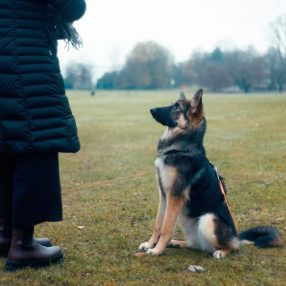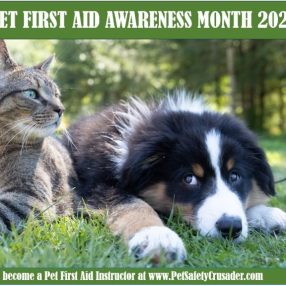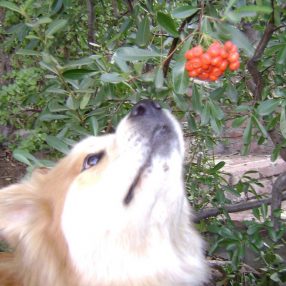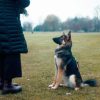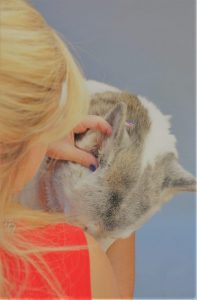
The average dog can hear better than the average person – about 4 times better, and canines are more adept at hearing sounds at higher frequencies. That is one reason I tell my senior pet care students to try using a higher octave when calling their hearing-challenged senior pet. Often as their auditory function wanes, the high notes can still be heard. Percussive clapping too sometimes will arouse a slightly deaf pooch.
Diseases such as diabetes, kidney failure and hypothyroidism may be associated with hearing loss, but mostly as a dog ages, much like his human counterpart, his hearing diminishes. The first signs of hearing loss may be not obeying commands or coming when called. Hearing loss due to age is usually a slow, progressive change, but it can create behavioral changes since your older fella doesn’t hear your approach. Always gently stomp feet to create a vibration or call out as you enter a room so as not to startle a hearing-challenged dog.
A dog’s ears are one of the most noticeable parts of his anatomy and are characteristic of his lineage, character and personality. There are many types of outer ears: large and drooping, as in the Beagle, Bloodhound or Cocker Spaniel; erect like the Akita, German Shepherd or Border Collie; or small and button-like as in a Bulldog or Chinese Sharpei.
From your vet’s perspective (and The Pet Safety Crusader’s when I teach about doing a weekly Head-to-Tail Check-up of your pet), the ears are a GRReat place to begin a physical exam to check for both specific and general diseases, but there is never any reason to routinely surgically remove a part of any dog’s ear. Not only barbaric, there are no justifiable health benefits. The way a dog carries his ears gives us insight into how he is feeling physically and emotionally, and his ear posture speaks volumes. By observing the carriage of a dog’s ears, we can understand, without hearing, what he may be trying to tell us. On the flip side, if a dog is carrying his ears in an unusual fashion, it could indicate disease, parasite infestation or nerve damage – a key to his overall health.
The ear can be divided into four parts:
- Ear Flaps which are upright or flop down
- External Ear Canal
- Middle Ear
- Internal/Inner Ear
The pinnae or flaps are very mobile and can be controlled independently, sort of like satellite dishes adjusted to the direction of sound. More than a dozen separate muscles control the movement of the ear, and the entire area is richly supplied with blood vessels and nerves, thus the reason ears can bleed a lot when injured and why I show my students special bandaging techniques to keep those tricky ears bandaged in place. The pinna of the external ear serves as a cartilage funnel, receiving air vibrations and transmitting them down the canal to the eardrum.
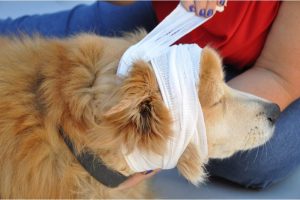
The ear canal is lined with both sweat (apocrine) and oily (sebaceous) glands which produce a protective coating we refer to as earwax. The canal is considerably longer than a human’s and after extending downward, makes a sharp turn inward toward the eardrum creating an “L” shape. Therefore, a complete examination requires use of an otoscope with long and thin cones, and rarely does a dog with an infection or obstruction allow thorough examination without anesthesia.
The ear drum and its three small bones, separate the external ear from the middle ear and is the area where vibrations are focused, amplified and then transmitted to the inner ear.
The inner ear has two main parts: the cochlea (hearing) and the vestibule and semicircular canals (balance). Envision these as a series of canals within the temporal bone.
Inside the cochlea are specialized hair cells that pick up vibrations. Equilibrium is controlled by electrical impulses that are registered on hair cells located in the three semicircular canals. These signals transmit the current status of the body in relation to the horizon. A dog with an inner ear infection of suffering from vestibular disease may find his balance, sense of direction and relation to gravity off.
Dogs with ear infections typically shake their heads and dig at their ears. They may even roll on the floor or ground to relieve the itching. A sniff of their ear canal can be an eye-opener as the odor ranges from foul-to-sweet. There could be visible discharge (clear, pus, black) and could be caused by bacteria, yeast or fungi as well as mites, excessive wax and oil or even second-hand smoke!
Ear infections can be allergy-related, so eliminating ingredients from your pet’s diet might prove helpful in determining the culprit. Ear mites are more common in cats, and that’s where many dogs get them from. Small parasites that roam freely in the ear, they can drive your pooch crazy rustling around in his ear. With veterinary help, mites are generally easy to treat, but their life cycle lasts three weeks, so make sure your treatment does as well.
Auricular hemotomas are also something to be aware of. Often caused by shaking of the head or smacking the ear flaps against a wall or other surface, tiny blood vessels break underneath the skin and for a pocket of “bleb” which needs to be drained or surgically excised.
The importance of keeping a dog’s ear clean and debris-free is a must to his hearing and balance. We never want to poke objects or have fluid collect in the inner ear. Long, floppy ears tend to trap moisture which creates an ideal petri dish for micro-organisms so may require weekly cleanings. Small, upright ears that allow air to circulate often stay cleaner and free of infection so may only require a once monthly wash. Besides removing dirt, your goal is to minimize excess wax and oil from obstructing the canal. Saline or plain water may do the job, but there are many ear washes, some with natural herbs, on the market these days. Alcohol may sting and can be drying to the ears. My recommendation is to always dampen a soft cloth or gauze square with the ear wash solution and gently wipe only as far as your first knuckle safely goes. No cotton swabs and never do this if you see inflammation, discharge or black dirt that resembles coffee grounds (actually dirt left behind by ear mites). In these cases, get to veterinary care. Sore ears became extremely painful when touched and you also risk pushing dirt and infection farther down the canal.
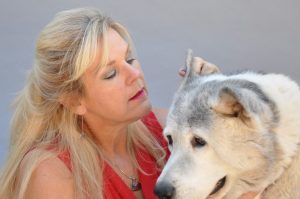
When ears are clean and healthy however, there’s almost nothing that will endear you more to your dog than an ear massage. Not only does it feel good and can be calming, you’re enhancing all the organ systems of his body simultaneously by improving blood flow and stimulating the nervous system. Simply rub gently around the entire base of the ear. Hold the base of the ear with one hand, take the earflap between fingers and thumb of the other hand, and rub in a circular fashion – from the base of the ear to its tip. Gently stretch the ear from base to tip.
Also catch my VLOG on this topic at https://youtu.be/Irt5v485XQM
_____________________________________________________________________________________
Denise Fleck is an award winning author and freelance writer. After extensive training, practice, more training and more practice, she developed her own Pet First-Aid & CPR curriculum and has been teaching animal life-saving skills for close to 20 years with many success stories to share. Additionally she developed a 5 month long Animal Care course for high school students in conjunction with the Burbank Unified School District and Animal Shelter. She has demonstrated animal life-saving skills on CBS –TV’s “The Doctors,” Animal Planet’s “Pit Boss,” “Kirstie Alley’s Big Life” and countless other shows. To complement her teachings, Denise created a line of Pet First-Aid Kits, posters and books for children teaching animal respect and care! Visit www.PetSafetyCrusader.com or call (818) 951-7962.
Note: The articles on this page are copyrighted. Please do not reprint or use portions for any purpose without written permission from the author. Request permission for usage by sending an email explaining how you’d like to use the materials and what parts specifically. Thank you in advance!


